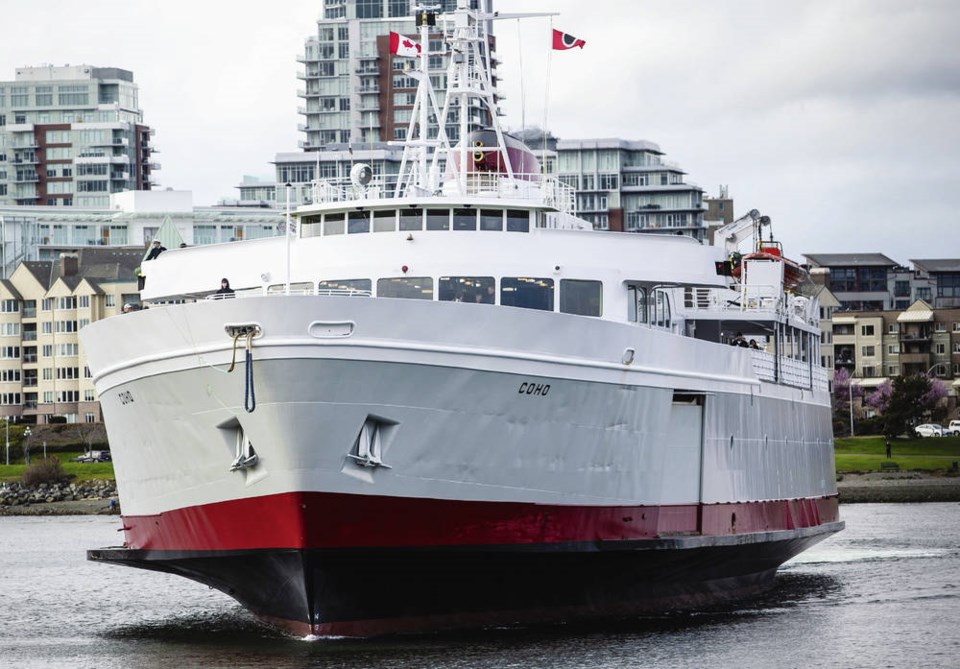Remember the 2010 Olympics, when every time you turned on the TV some grinning idiot with a microphone would point to the packed streets and gush about B.C. enjoying the best party ever?
“No,” you’d say, “Vancouver is having a party.” Victoria’s streets were about as packed as a Trudeau rally in downtown Calgary.
Which is what came to mind Monday when stories poured in of American tourists lining up at Canadian land border crossings for the first time in a year and a half. We might be welcoming back double-vaccinated, COVID-tested U.S. visitors, but the ferry services that normally shuttle them from ’Merica to Vancouver Island remain tied up for the foreseeable future.
Ferry operators got the bad news Monday in a conference call with Canadian border authorities: Even though Americans may now cross into Canada, international ferry services remain suspended. No Coho from Port Angeles. No Clipper from Seattle. No Sidney-Anacortes ferry. That’s a huge chunk of the U.S. tourists who descend on Victoria each year.
“I’m a bit blindsided by it, quite frankly,” said Clipper Navigation CEO David Gudgel.
“It doesn’t seem to make sense,” says Black Ball president Ryan Burles, whose company runs the Coho. Why open the border to those arriving by land and air, but not ferry?
Maybe it’s a case of the U.S. and Canada holding off until they can act in concert, with both countries accepting each other’s citizens. As it is, the U.S. won’t admit Canadian tourists by land (we never were stopped from flying there) until Aug. 21 at the earliest. Whatever’s going on, the ferry operators (who also include Washington State Ferries, which didn’t plan to resume its Sidney-Anacortes run until the end of September, anyway) just want the authorities to give them some idea of what the future looks like.
It doesn’t make financial sense for Black Ball to resume sailings until it can carry both Canadians and Americans, but it would at least like a clearer picture. “We just want some sort of road map, some sort of clarity,” Burles said.
There are plenty of Islanders who would be just as happy to seal the border entirely, whether it be to foreigners arriving by land, sea or air. But there are others for whom severing the link to the other side of Juan de Fuca Strait has been like walling off a part of their lives. This isn’t just a tourism story.
Remember that crossing between Victoria and Port Angeles used to be just like climbing on a bus. In pre-9/11 days, you didn’t even need a passport. For many cross-the-strait Americans, pre-pandemic Victoria was the big city where they went for everything from dentistry to good Chinese food.
When Victoria’s Marsha Birney was growing up in Port Angeles, Victoria was a place kids went to play baseball or to sing with other choirs. She remembers riding the legendary Kalakala ferry (with its art deco styling, it looked like a giant Airstream trailer) in the late 1950s. “It was a tub. It was horrible.” She would make the crossing with her British-born grandmother, who made a beeline for the Woodward’s food floor and the English ingredients for her Christmas baking.
Birney ended up living on this side of the border half a century ago after meeting her Canadian husband Bill in San Francisco. They moved from the Lower Mainland to Victoria in 1990. Life in the capital might be grand (Sunday found her volunteering at the Times Colonist book drive, just like she always does) but being cut off from Port Angeles has meant being cut off from people she loves.
In a normal year she might pop over three or four times, but that hasn’t been the case since the crossings were closed in March 2020. She really misses the family cabin at Lake Sutherland. “When the border closed, that was the first time I hadn’t been to the lake in 66 summers.”
Birney has been keen to check on an aunt who might still be living on her own, and who was game enough to can peaches last week, but is still 98 years old. “It has been tough,” she said.
At least the land border openings give her the option of an eight-hour odyssey involving ferrying to Tsawwassen, crossing at the Peace Arch, driving to Anacortes, then ferrying to Port Townsend. As for the strait, it still looks like a moat.



